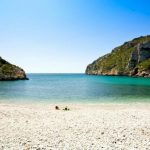Nestled along Spain's Costa Blanca, Jávea (Xàbia in Valencian) is a picturesque town that offers visitors stunning Mediterranean views, historic charm, and a wealth of natural wonders. Among its most captivating attractions are the caves and coves dotting its coastline, a testament to millennia of geological activity and natural artistry. These hidden gems provide a unique blend of adventure, relaxation, and sheer beauty, making them a must-visit for travelers seeking an unforgettable experience.
In this article, we’ll take a journey through Jávea’s most iconic caves and coves, exploring their history, features, and the best ways to enjoy them.
1. The Enchanting World of Sea Caves
Jávea’s sea caves are a testament to nature’s ability to carve breathtaking beauty over thousands of years. These formations, shaped by the relentless force of the sea, offer visitors an otherworldly experience.
Cova Tallada
Cova Tallada, meaning “Carved Cave,” is one of the most famous spots along Jávea’s coastline. This historical cave, partially carved by humans during the Moorish period, was once used to extract tosca stone for building purposes. Today, it’s a favorite destination for adventurous souls.
- Features: Inside, visitors will find natural pools, stalactites, and openings that provide stunning views of the Mediterranean Sea.
- How to Access: Reachable via a scenic hiking trail from Les Rotes in Denia or by kayak or paddleboard from Jávea. The journey itself is an adventure, with dramatic cliffs and azure waters accompanying your path.
- Tips: Due to its popularity, permits are often required during peak season, so plan ahead.
Cova del Llop Marí
Another captivating cave, the Cova del Llop Marí (Cave of the Sea Wolf), is named after a monk seal species that once inhabited the area. Its secluded location and crystal-clear waters make it a hidden treasure.
- Features: This cave is accessible only by sea, and entering it feels like stepping into a natural cathedral. The sunlight filtering through the water creates a mesmerizing glow.
- Activities: Perfect for snorkeling and kayaking enthusiasts who love exploring hidden corners of nature.
2. Hidden Coves of Tranquility
Jávea’s coves are equally alluring, offering serene spots for sunbathing, snorkeling, and soaking in the beauty of the Mediterranean.
Granadella Cove
Consistently ranked as one of Spain’s most beautiful beaches, Granadella Cove is a small pebble beach surrounded by rugged cliffs and lush greenery.
- Features: Its turquoise waters are ideal for swimming, snorkeling, and paddleboarding. The cove’s underwater world is teeming with marine life, making it a diver’s paradise.
- Accessibility: Accessible by car, with parking available nearby. Early arrival is recommended during the summer months.
Portixol Cove
Also known as Cala la Barraca, Portixol Cove is another jewel in Jávea’s crown.
- Features: This cove is renowned for its traditional fishermen’s houses and panoramic views. It’s a fantastic spot for snorkeling and exploring the diverse marine ecosystem.
- Dining: Nearby restaurants serve fresh seafood, allowing visitors to enjoy a delicious meal with breathtaking views.
Cala Blanca
True to its name, Cala Blanca (White Cove) boasts pristine white rocks and crystal-clear waters.
- Features: This cove offers a peaceful retreat away from the crowds. It’s a great spot for snorkeling or simply relaxing on the beach.
- Pro Tip: Explore the connecting coves and hidden inlets by kayak for an adventurous day out.
3. Activities to Enhance Your Exploration
Exploring Jávea’s caves and coves isn’t just about admiring the views—it’s also an opportunity to engage in exciting activities. Here are some popular options:
- Snorkeling and Diving: The crystal-clear waters of Jávea are a haven for underwater enthusiasts. Dive into the vibrant marine world, where you’ll encounter colorful fish, coral, and other marine life.
- Kayaking and Paddleboarding: Glide along the coastline to access secluded caves and coves. Rentals and guided tours are widely available.
- Hiking: Many caves and coves are accessible via scenic hiking trails. Montgó Natural Park offers routes with spectacular views of the coastline.
- Boat Tours: For those who prefer a more relaxed approach, boat tours provide a comfortable way to explore the coastline’s hidden treasures.
4. Practical Tips for Visiting
- Best Time to Visit: Spring and early autumn offer the best weather and fewer crowds. Summer is ideal for water activities but can be busier.
- What to Bring: Comfortable shoes for hiking, snorkeling gear, sunscreen, and plenty of water are essential.
- Respect Nature: These natural wonders are fragile ecosystems. Avoid littering, and follow local guidelines to preserve their beauty for future generations.
5. Beyond the Caves and Coves
While the caves and coves are undoubtedly Jávea’s highlights, the town itself offers a rich cultural and historical experience. Wander through the old town with its narrow streets and Gothic architecture, visit the iconic San Bartolomé church, or enjoy the vibrant culinary scene featuring fresh seafood and traditional Valencian dishes.
Conclusion
Exploring the caves and coves of Jávea’s coastline is an experience that blends adventure, natural beauty, and tranquility. Whether you’re kayaking into a hidden cave, snorkeling in turquoise waters, or relaxing on a secluded beach, Jávea promises memories that will last a lifetime. This enchanting destination is a testament to the magic of the Mediterranean, offering something special for every traveler.
Frequently Asked Questions (FAQs)
What are the best caves to visit in Jávea?
Cova Tallada and Cova del Llop Marí are must-visit caves, offering unique natural beauty and thrilling exploration opportunities
Which coves are ideal for snorkeling in Jávea?
Granadella Cove and Portixol Cove are excellent for snorkeling due to their clear waters and vibrant marine life
Do I need a permit to visit Cova Tallada?
Yes, during peak season, permits are required. Be sure to check the official website for details
What is the best time to explore Jávea’s coastline?
Spring and early autumn offer pleasant weather and fewer crowds, making it ideal for exploration
Are the coves in Jávea family-friendly?
Yes, many coves, like Granadella, are suitable for families, though some may require careful access




